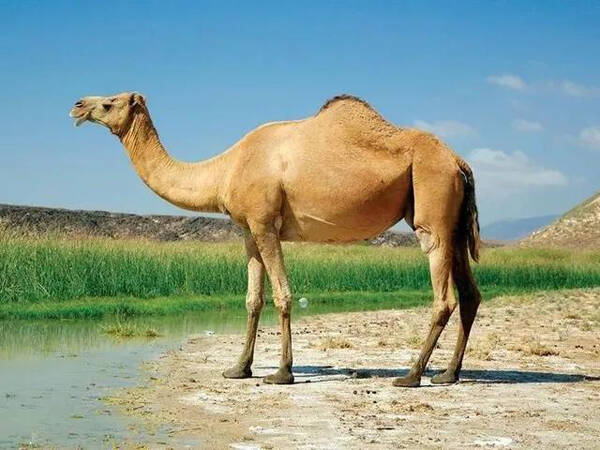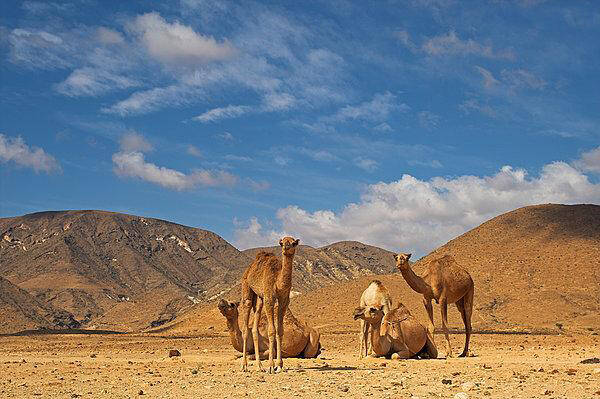Camelus dromedarius
IUCN
LCBasic Information
Scientific classification
- name:Camelus dromedarius
- Scientific Name:Camelus dromedarius,dromedary
- Outline:Ungulata
- Family:Artiodactyla Camelidae Camel
Vital signs
- length:2.25-3.45m
- Weight:300-690kg
- lifetime:35-40years
Feature
It is named after its hump and is the national animal of Egypt.
Distribution and Habitat
The dromedary is extinct in the wild. It was once distributed in the Arabian Peninsula, including Saudi Arabia, Yemen, Oman, Qatar, Kuwait, the United Arab Emirates, Senegal, Mauritania, Somalia and Kenya. The entire northern wild population was domesticated in Africa about 4,000 years ago and is distributed in Algeria, Tunisia, Libya, Egypt, Morocco and Iran.
It lives in dry and water-scarce Gobi areas. Its unique body structure enables it to adapt to the windy and sandy weather in the desert, so it is called the ship of the desert.
Appearance
The dromedary is named for its hump. The head-torso length is 2,250-3,450 mm, the tail is 350-550 mm, the shoulder height is 1,800-2,300 mm, and the weight is 300-690 kg. It is slightly taller than the Bactrian camel, with a thinner body and longer legs. The fur is dark brown to dark gray, shorter and softer than the Bactrian camel, and the legs are longer. The head and neck are long, the tail is short, the eyelashes are thick, the ears are small, the upper lip is deeply cleft, the nostrils are flat and slit-like, and the hooves are wide and fan-shaped. Dromedaries are relatively large animals, their necks are relatively slender, their heads are relatively small and longer. Their legs are relatively thin.
The feet of dromedaries are different from those of most other even-toed ungulates. Most even-toed ungulates stand on the kick of their toes, while dromedaries stand on the last two segments of the toes. They do not have hooves, but have curved toenails that only protect the front
Details
The dromedary camel (scientific name: Camelus dromedarius) is also known as dromedary in English. It has no subspecies and is slightly taller than the Bactrian camel. It has a thinner body and longer legs than the Bactrian camel.

Camels are quite able to endure hunger and thirst. After drinking enough water, they can go without water for several days and still move around in hot and dry desert areas. Because there are many very thin and tortuous ducts in their noses, the ducts are usually moistened by liquid. When the body lacks water, the ducts immediately stop secreting liquid and form a layer of hard skin on the surface of the ducts, which absorbs the exhaled water without losing it outside the body; when inhaling, the water in the hard skin can be sent back to the body. Water is repeatedly circulated in the body and used, so it can withstand thirst. The stomach is divided into 3 chambers (lacking omasum), and can ruminate. It has a gentle temperament and often moves alone, eating coarse grass and shrubs. The body temperature of camels is 34 degrees Celsius at night and as high as 41 degrees Celsius during the day. Only when it is higher than this body temperature will the camel begin to sweat.
Dromedaries are animals that are active during the day. Wild dromedaries live in groups, each group consists of a male and multiple females with their common young. Adult male young will be expelled from the group and form a bachelor group. Males will fight fiercely to become the leader of the group. Dromedaries can be comfortable living alone or in groups with camels. They often become very excited when unfamiliar animals approach them. Dromedaries express their unhappiness by stamping their feet and running, which often gives people the impression of bad temper and stubborn personality because of their "spitting" and "kicking" actions.

When male dromedaries fight, they mainly stretch their heads between the legs of their opponents, trip them up, and then bite them with their mouths. At this time, it is common to see dromedaries acting alone, and they are often the losers in courtship battles. There are also cases where male dromedaries run to the herd of domestic camels and mate with female domestic camels. Females reproduce once every two years, with a gestation period of 12-14 months, and give birth in March-April of the following year, with one baby per litter. The baby can stand up 2 hours after birth, and can follow its parents on the same day, and will not separate until 1 year later. It reaches sexual maturity at the age of 4-5 years, and has a lifespan of 35-40 years. Bactrian camels and dromedaries can crossbreed, and their offspring are fertile. Such hybrids either have only one elongated hump, or one large and one small hump. Camelids in America can also crossbreed. Alpacas can also crossbreed with dromedaries or Bactrian camels through artificial insemination.
Dromedaries are raised in Arabia, India and North Africa. Dromedaries are native to North Africa and western and southern Asia. Although they have long been extinct in the wild, some have been re-wilded, such as the dromedaries introduced to Australia, which have formed a certain scale of wild populations in the Australian desert. Because they are basically artificially bred species, they are not included in various wildlife protection plans.
Protect wildlife and eliminate game.
Maintaining ecological balance is everyone's responsibility!








